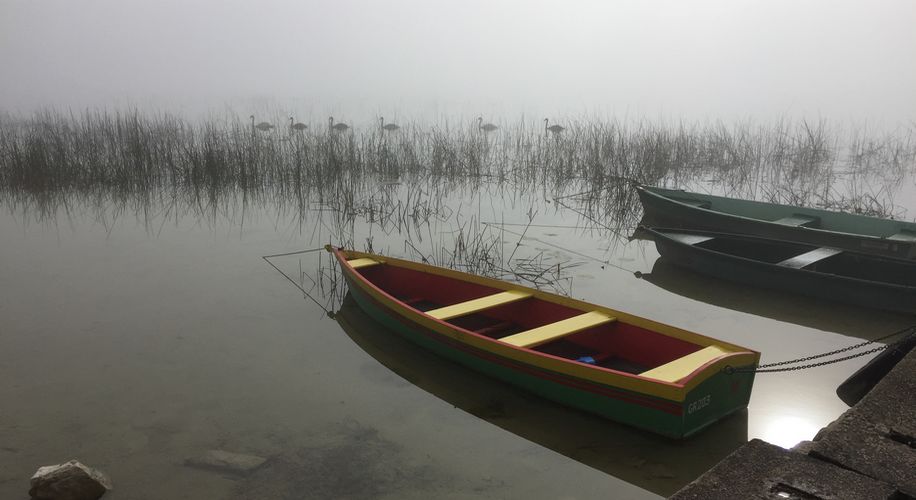Inventory survey – an instrumentation search was organized with the means of a side scan sonar, a sounder and an underwater magnetometer. Indeed the mass of accumulated sediments did not allow a visual propection.
The data collection was carried out over three days between November 12 and 14, 2016. The equipment used is the “Humminbird HELIX 7 SI GPS” which includes the functions of bathymetric survey, side scan sonar and down imaging. Autochart Pro software allows data exploitation and hardness treatment of the soil.
A zodiac with thermal engine made it possible to take the readings. However, the transom was not wide enough, the probe could not be placed at a good distance from the engine. It was positioned sometimes at the front sometimes on the side of the boat, without the distance between the probe and the GPS creating a significant deviation of GPS positioning. The zero level was taken over like that established by Vincent BICHET in his previous studies, ie the level of the upper apron of the dam.
The three days of surveys showed an exceptionally nike metcon 9 high lake level, more than 1m above. All data has been corrected to return to the site zero level. There are 18,597 registrations. The passes for the surveys were crossed a first time in the east Женские высокие кожаные кроссовки nike air jordan 1 mid cheerless smoke grey#найк — цена 1950 грн в каталоге Кроссовки ✓ Купить женские вещи по доступной цене на Шафе , Украина #96477706 , Heres a recap of the Jordan Brand 32 South State Fashion Show / west direction then north / south. Given the surface area of the lake of 7.5 ha, we therefore collected a recording every 4.03m² or 0.247 points per m². With regard to the “recommendations for the conduct of a bathymetric survey carried out in the port, coastal or fluvial domain”, the finest level recommended for an obstacle search and the monitoring of submerged structures is 1 point per m².
The different surveys made it possible to obtain different 3 D images.
3D bathymetry representation
 Document R. GREBOT
Document R. GREBOT
3D soil hardness representation
 Document R. GREBOT
Document R. GREBOT
MAGNETOMETRY: The data collection was carried out on 11/27/2016 between 11 a.m. and 12:30 p.m. according to the methodology described below. The equipment used is a Towfish Aquascan proton magnetometer and its MC5 microprocessor. An inflatable plastic-bottomed zodiac with heat engine made it possible to tow the fish hanging under a float (30 cm deep) with a cable length of 25 meters between the float and the boat, at an average speed of 4km. The number of registrations made is 5,486 points.

The recorded GPS position is that of the float where the GPS sensor was positioned and connected to the boat by a 30 meter USB cable. So that the two cables do not separate, and that they do not get caught in the vegetation. They have been inserted in lengths of polyester “chips” which allow the cables to float.
 distance between two passes is 18m. The sensitivity of the Aquascan MC5 and the average depth of 6 m allow, in theory womens air jordan 6 barely rose dh9696 100 release date, the detection of a magnetic anomaly with a minimum value of 40 kg of ferrous mass, with a variation air jordan 30 quai 54 cosmos 863586 010 from 1 nano tesla. These values are only indicative, they depend on the shape, the magnetization and the volume of the object.
distance between two passes is 18m. The sensitivity of the Aquascan MC5 and the average depth of 6 m allow, in theory womens air jordan 6 barely rose dh9696 100 release date, the detection of a magnetic anomaly with a minimum value of 40 kg of ferrous mass, with a variation air jordan 30 quai 54 cosmos 863586 010 from 1 nano tesla. These values are only indicative, they depend on the shape, the magnetization and the volume of the object.

The float with the fish and the GPS on the float towed with 25m of coaxial cable and the USB cable inserted in polyester “fries”.
54 one-off anomalies were recorded. They have been grouped into 22 zones given their proximity to each other. Apart from a finding of a significant number of anomalies in the context of a survey whose results are validated, no interpretation can be made at present.
